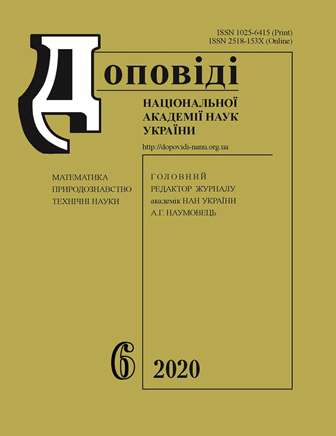Azomethine derivatives of p-ami nobenzoic acid as antioxidants and xanthine oxidase inhibitors
DOI:
https://doi.org/10.15407/dopovidi2020.06.074Keywords:
antioxidant properties, azomethines, hydroxyl radicals, inhibition, molecular docking, xanthine oxidaseAbstract
Antioxidant properties of hydroxylated azomethine derivatives of p-aminobenzoic acid and their inhibitory effect on xanthine oxidase activity have been established. Analysis of inhibitory activities of a series of synthe sized azomethine compounds towards xanthine oxidase, as well as molecular docking study indicated that carboxylate and hydroxyl groups can be involved in mechanisms of the enzyme inhibition. The azomethine derivatives are shown to exhibit the mixed type of inhibition, and inhibitory activities of some of them are in the micromolar ranges. The effect of the most active 4-(((1E)-(2-hydroxy-5-nitrophenyl)methylene)amino)benzoic acid was comparable to that of the known inhibitor allopurinol. According to molecular docking results, the carboxylate group of the azomethine inhibitor can form hydrogen bonds with the amino acid residues of Arg880, Thr1010, and Glu1261 in the active site of xanthine oxidase, while the hydroxyl group is close to the residues of Glu802 and Asn768. In addition, aryl groups of the inhibitor molecule form contacts with Phe914, Phe1009, Leu648, Phe1013, and other amino acid residues. The antioxidant activity of the azomethines is evaluated in the model system by the detection of malonic dialdehyde with the thiobarbituric acid test. The ability of some compounds to neutralize hydroxyl radicals exceeded the effect of trolox as a reference antioxidant.
Downloads
References
Pacher, P., Nivorozhkin, A. & Szabó, C. (2006). Therapeutic effects of xanthine oxidase inhibitors: renaissance half a century after the discovery of allopurinol. Pharmacol. Rev., 58, No. 1, pp. 87-114. https://doi.org/10.1124/pr.58.1.6
Voelker, R. (2019). Another warning for febuxostat. JAMA. 321, No. 13, pp. 1245. https://doi.org/10.1001/jama.2019.3043
Prakash, A. & Adhikari, D. (2011). Application of Schiff bases and their metal complexes-A review. Int. J. Chem. Tech. Res., 3, No. 4, pp. 1891-1896.
Paşa, S., Tuneğ, M. & Boğa, M. (2019). Biological surveying of diverse Schiff base compounds: antiproliferative, antiradical and enzyme inhibition activity. Pharm. Chem. J., 53, No. 4, pp. 302-311. https://doi.org/10.1007/s11094-019-01997-y
Ali, Z. Y., Mohamed, S. A. & Edrees, M. M. (2012). Biological screening for some newly synthesized pyrazolo[3, 4-d]pyrimidine derivatives. Nat.Sci., 10, No. 7, pp. 58-69.
Titinchia, S. J. J., Abbo, H. S. & Saeed, A. A. H. (2004). Synthesis, spectroscopic and molecular structures investigations of some carboxylated schiff bases. J. Mol. Struct., 705, No. 1-3, pp. 121-126. https://doi.org/10.1016/j.molstruc.2004.06.025
Aruoma, O. I. (1994). Deoxyribose assay for detecting hydroxyl radicals. Methods Enzymol., 233, pp. 57-66. https://doi.org/10.1016/S0076-6879(94)33008-5
Manchot, W. & Furlong, J. R. (1909). Über Isomerie bei Anilen (Schiffschen Basen). (2. Mitteilung). Chem. Ber., 42, No. 3030, pp. 4383-4389. https://doi.org/10.1002/cber.19090420429
Khan, M. I., Khan, A., Hussain, I., Khan, M. A., Gul, S., Iqbal, M., Rahman, I.-U. & Khuda, F. (2013). Spectral, XRD, SEM and biological properties of new mononuclear Schiff base transition metal complexes. Inorg. Chem. Commun., 35, pp. 104-109. https://doi.org/10.1016/j.inoche.2013.06.014
Exner, O. & Lakomý, J. (1970). Studies on the inductive effect. VII. Inductive and mesomeric effects of nitrogen and oxygen substituents. Collect. Czech. Chem. Commun., 35, pp. 1371-1386. https://doi.org/10.1135/cccc19701371
Dikusar, A. E. (2012). Synthesis of (E)-2-methoxy-6-(R-imino)methylphenols and 2-methoxy-6-(R-amino) methylphenols. Rus. J. Gen. Chem., 82, No. 4, pp. 693-696. https://doi.org/10.1134/S1070363212040159
Cronenberger, L., Gaige, T., Pacheco, H. & Pillon, D. (1968). Nouvelles bases de Schiff dérivées des aldehydes dihalogéno-3,5 salicyliques et possédant des propriétés antifongiques et antibactériennes. Chim. Ther., 3, No. 2, pp. 87-99
Jiayi, S., Min, Z. & Changyan, S. (2019). A highly selective fluorescent chemosensor for Al(III) ions based on 2-hydroxy-1-naphthaldehyde derivative. Can. J. Chem., 97, No. 5, pp. 387-391. https://doi.org/10.1139/cjc-2018-0141
Brewster, C. M. & Millam, L. H. (1933). Phototropic and thermotropic anils from 5-bromosalicylaldehyde. J. Am. Chem. Soc., 55, No. 2, pp. 763-766. https://doi.org/10.1021/ja01329a049
Muzychka, O. V., Kobzar, O. L., Popova, A. V., Frasinyuk, M. S. & Vovk, A. I. (2017). Carboxylated aurone derivatives as potent inhibitors of xanthine oxidase. Bioorg. Med. Chem., 25, No. 14, pp. 3606-3613. https://doi.org/10.1016/j.bmc.2017.04.048
Downloads
Published
How to Cite
Issue
Section
License
Copyright (c) 2023 Reports of the National Academy of Sciences of Ukraine

This work is licensed under a Creative Commons Attribution-NonCommercial 4.0 International License.




